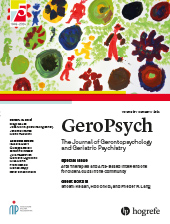Neuropsychologische Untersuchungsverfahren eines averbalen Demenzscreenings für Migrations-Patienten
Abstract
Screeningtests bei Verdacht auf eine Demenz, die auch bei Personen durchgeführt werden können, die die Sprache des Untersuchers nur schlecht beherrschen, sind noch nicht ausreichend erprobt. In zwei Stichproben von Migranten ab 60 Jahren (Demenzpatienten und nicht-demente Kontrollprobanden) wurden sechs neuropsychologische Untersuchungsverfahren angewendet, die einfach in der Handhabung sind und nur wenig Zeit beanspruchen. Hypothese war, dass die Tests des averbalen Gedächtnisses (z. B. eine einfache abstrakte Figur und Wiedererkennen von Figuren), der Orientierung und Tests der Apraxie (z. B. Uhrentest und Hand-Faust-Sequenzen), sowie logische Reihen des LPS (Untertest 3) eine gute diagnostische Differenzierung erlauben. Die Ergebnisse zeigen für alle Tests zwar signifikante Gruppenunterschiede, jedoch auch deutliche Unterschiede in der diagnostischen Trennschärfe. Am besten bewährte sich eine neue Version der Messung der zeitlichen Orientierung in einer Multiple Choice Version, die das Anstreichen des richtigen Datums verlangt und die Kopie und Rekonstruktion einer einfachen abstrakten Figur. Ein kurzes Demenzscreening für Patienten mit Migrationshintergrund erscheint möglich.
Screening tests for the diagnosis of dementia, which could be applied to subjects, who cannot speak the language of the investigator good enough, are not available. In two groups of migrants (age 60 years and more), namely, patients who received the diagnosis of a dementia syndrome of Alzheimer type, and a group of nondemented control subjects a neuropsychological test battery of 6 tests was applied. The tests are simple in the application and need only short time for the examination. The hypothesis was, that the tests of averbal episodic memory (e. g., a simple abstract figure for copy and reconstruction from memory),orientation to time and tests of apraxia (e. g., clock drawing and hand-fist sequences) as well as logical sequences (odds out, LPS subtest 3) demonstrate a good diagnostic power. The results show for all tests statistically significant group differences, but also marked differences in the diagnostic validity. The best tests were the new multiple choice orientation test and the new test of copy and reconstruction of a simple abstract figure. A short dementia screening seems to be possible.
Literatur
(2001). From conditioning to conscious recollection. New York: Oxford University Press.
(2004). Neuropsychological assessment (4th ed.). New York: Oxford University Press.
(
in Vorbereitung ). Averbal test battery for the detection of dementia.(1993). Clockdrawing and dementia in the community: A longitudinal study. International Journal of Geriatric Psychiatry, 8, 487–496.
(1986). The challenge of time: Clockdrawing and cognitive function in the elderly. International Journal of Geriatric Psychiatry, 1, 135–140.
(1993). Leistungsprüfsystem für 50–90-jährige (LPS 50+). Testmappe. Göttingen: Hogrefe.


